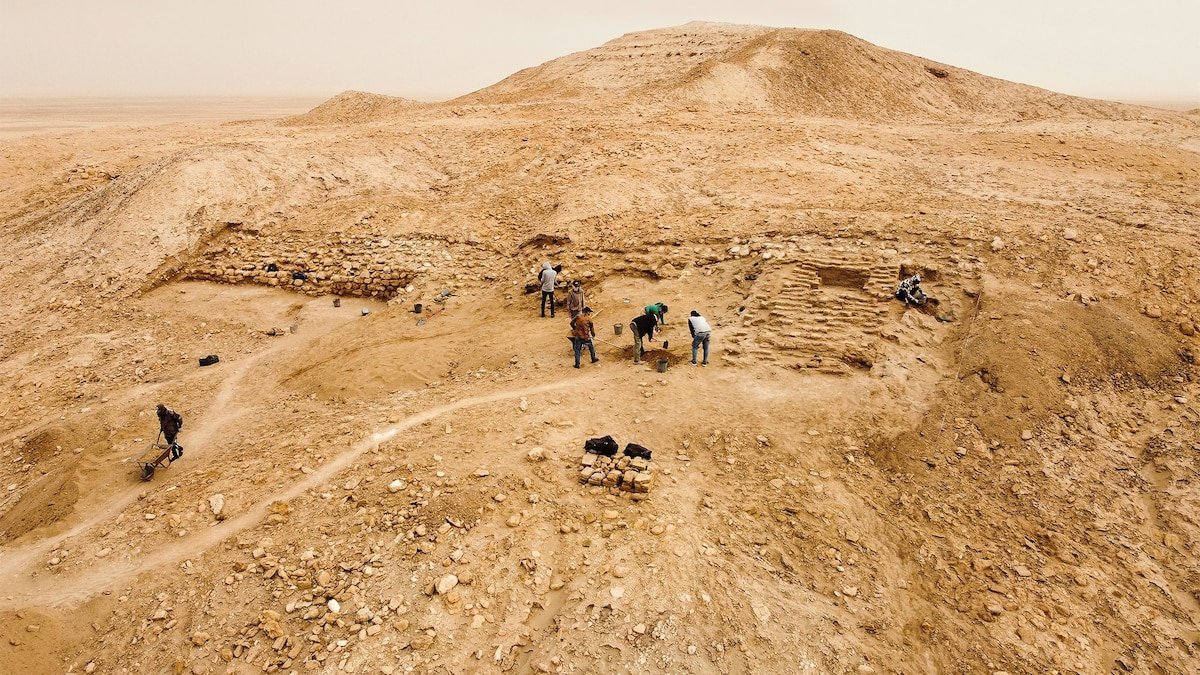Buried in the Mesopotamian desert, undisturbed for over two millennia lay a hidden key to understanding one of the world’s oldest known civilizations.
In 1854 British official John George Taylor was sent on an excavation mission to the desert of southern Iraq by the British consul general in Baghdad. Taylor, an agent of the East India Company and British vice-consul at Basra, was commissioned with investigating a remote site called Tell Abu Shahrain, where there was a series of tells, or mounds, made up of debris left by human settlements. At first, Taylor was unimpressed. In the excavation report published in 1855, he wrote: “My visit this year to Abu Shahrein [sic] has been unproductive of any very important results.” He even questioned whether it had been worth transcribing his field notes.
Taylor had been hoping to uncover something impressive: statues, inscriptions, evidence of palaces and temples. What he found instead, in the short time he had available, were walls, drainage systems, stone platforms, and the remains of limestone columns decorated with mosaic cones.
In his journal, Taylor highlighted finding a statue of a black granite lion lying on the surface. Even counting the lion, however, Taylor must have thought this too meager a haul to justify a second expedition. Only later would it be revealed how these unpromising mounds were the remnants of one of the oldest cities on Earth: Eridu.
Before the flood
Eridu was a foundational city in Sumerian culture, the world’s earliest known civilization, which flourished from around the fourth to second millennia B.C. in what is now Iraq.
(This ancient society helped build the modern world.)

Model of a skiff from Eridu, first half of the fourth millennium B.C.
Interfoto/ACI
Eridu’s significance is evidenced by the Sumerian King List, various versions of which were inscribed in cuneiform toward the end of the third millennium B.C. The latter part of the list includes cities with royal dynasties that can be verified from historical records. The early part of the list is more legendary, recording the original royal cities that existed before “the Flood” (an event that may reflect a regional catastrophe or may be related to the biblical story in Genesis where the whole Earth was flooded). The first of these antediluvian royal cities was Eridu: “After the kingship descended from heaven, the kingship was in Eridu … In five cities, eight kings … Then the flood swept over.”
Of immense symbolic importance, Eridu was also home to the largest temple dedicated to Enki, the god of water and wisdom, a key deity of the Sumerian pantheon. For centuries, this shrine attracted pilgrims from all over Mesopotamia to Eridu.
An interest in Eden
Despite Taylor’s disappointment, his initial findings piqued the interest of scholars. Although no large-scale excavations were carried out in the decades that followed Taylor’s visit, officials at the British Museum remained interested in the site. In 1918, just before the end of World War I, museum officials commissioned Assyriologist Reginald Campbell Thompson to carry out excavations at the site. For a month, Campbell made archaeological surveys, using Ottoman prisoners of war as laborers. The following year, British Egyptologist Harry R.H. Hall arrived with the aim of identifying the site’s monumental buildings.

This idealized reconstruction imagines what Eridu may have looked like at the height of its power in 3300 B.C. The city was centered around the temple of Enki. This likely comprised an elevated platform that incorporated the remains of previous temple buildings. The sanctuary itself appears to have been quite a large rectangular structure (approximately 65 feet by 40 feet) with an elongated central chamber, called a cella. There would also have been an access staircase.
Balage Balogh/Scala, Florence
Finding the ziggurat
It was not until 1946, however, that the first large-scale excavations began. Iraq had gained independence from Britain in 1932, and the Iraqi government was keen to fund archaeological projects that might lend prestige to their nation-building narratives.
At the end of World War II, the Department of Antiquities of Iraq relaunched research at the site of Eridu under the direction of Iraqi archaeologist Fuad Safar, assisted by British archaeologist Seton Lloyd. Safar and Lloyd knew each other well, having worked together at Tell Uqair, near Baghdad. They believed that fully excavating Eridu could byield important data on the earliest phases of Mesopotamian history.
Glimpses of Eridu
Excavations at Eridu have uncovered a large number of objects spanning a wide period of Mesopotamian history. These votive cones, inscribed with details of the king and left in the foundations of monuments, date to the reign of Lipit-Ishtar in the 20th century B.C.
Bridgeman/ACI
They concentrated their efforts on Mound 1, an 82-foot-high tell covering an area of some 1,900 by 1,770 feet. Before long, they uncovered the remains of an unfinished ziggurat, or step pyramid, built at the end of the third millennium B.C. by a ruler of the 3rd dynasty of Ur, a late, short-lived Sumerian state. But what really intrigued Safar and Lloyd was what lay hidden beneath the remains of that ziggurat.
(They were scouting for oil in Iran. They found an ancient temple instead.)
City upon city
They were not disappointed. Beneath remains dating to the Ur III (21st century B.C.) period were more levels of human occupation.
You May Also Like
As they dug further, they hit a stratum dating to the Uruk period (4500–3200 B.C.). Below that were remains from as far back as the protohistoric, pre-Sumerian Ubaid period (5300–3800 B.C.) As they worked, they found multiple reconstructions of the temple of Enki, made over the course of two millennia, along with other places of worship.
Italian Mesopotamian historian Mario Liverani writes that Eridu’s temples were “reconstructed and expanded after each collapse, and their remains formed a raised platform on which new temples were constructed.” As the temple of Enki was repeatedly rebuilt on the same site, its structure evolved.
According to Liverani, new iterations of the temple became progressively larger from the middle of the fourth millennium B.C.: “These imposing buildings … by far superseded anything ever built until then.” Their emergence marks a transition from worshiping at home to worshiping at specially built places. In parallel with this process, there is evidence of more complex social hierarchies emerging in the city.
The reconstructions of the temple stopped around 3200 B.C. A millennium later, with the brief return of Sumerian power under Ur III, the ziggurat would be erected on the ruins of all that had gone before.
(The ancient empire that civilization forgot.)
More secrets
Although Eridu declined, it continued to have relevance, probably as a place of pilgrimage. Excavation of surrounding tells provided more clues to the timeline. Mound 2 contained the remains of a palace complex dating to the first half of the third millennium B.C. Mounds 3, 4, and 5 contain pottery dating to the second and first centuries B.C. but no remains from residential buildings. The city was only sparsely populated by that time.
Safar and Lloyd’s research was finally published in 1981. Despite the political instability of the region, Italian and French archaeologists seek to resume excavations at Eridu, the first city of the earliest civilization, and reveal more secrets.
(This ancient Silk Road town was almost lost to time.)
This story appeared in the March/April 2025 issue of National Geographic History magazine.











